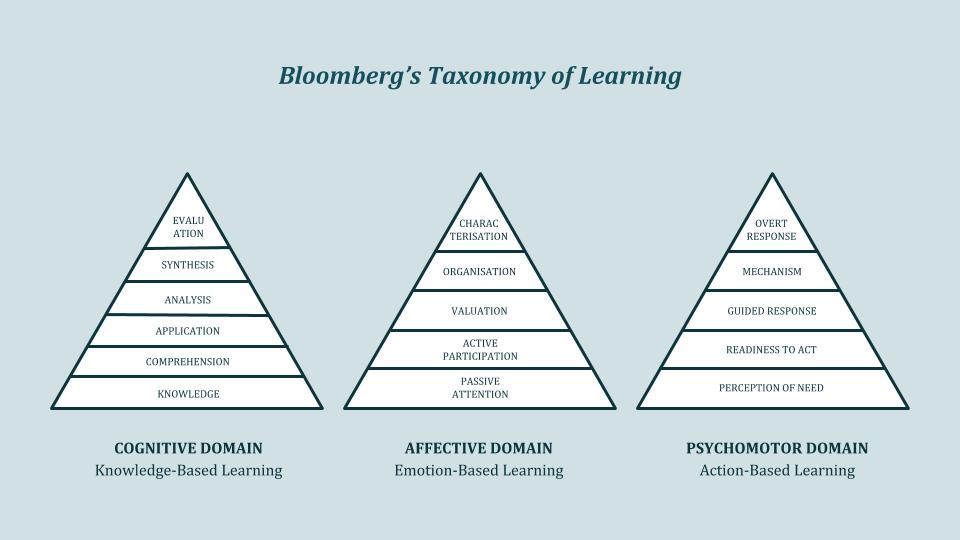Developing metacognitive skills is essential to being productive while taking care of your mental health. While some tools such as journaling or the Eisenhower matrix are already well known, there are other tools borrowed from the world of education. Here are five thinking tools you can add to your metacognitive toolbox.
1. Bloom’s taxonomy of learning
When studying a topic, it may be hard to define our learning objectives. Bloom’s taxonomy is Bloom’s taxonomy is a set of three lists used to classify educational learning objectives into levels of complexity and specificity. The three lists focus respectively on learning objectives in the cognitive domain (knowledge-based), affective (emotion-based) and psychomotor domains (action-based).
- Knowledge-based objectives. The six levels of the cognitive domain are knowledge, comprehension, application, analysis, synthesis, and evaluation. Instead of just memorising facts, the goal of this domain is to be able to remember, understand, apply, analyze, create, and evaluate our knowledge.
- Emotion-based objectives. There are five levels in the affective domain, which measures how much you care about what you are studying: passive attention (the lowest level), active participation, valuation, organisation, and characterisation (the highest level, where you care enough to generate your own take on the knowledge).
- Action-based objectives. Finally, the psychomotor domain measures your ability to actually manipulate relevant tools. The skills in the psychomotor domain include: perception (where you sense the need for a tool), readiness to act, guided response (where you can reproduce someone’s use of a tool), mechanism (where the use of the tool becomes natural), and complex overt response (where you can alter existing tools or even build your own tools).
These three models were named after Benjamin Bloom, the author of Taxonomy of Educational Objectives: The Classification of Educational Goals. As part of the process of learning how to learn, using these hierarchical lists can help you track your learning progress in a more structured way.
2. The DOVE & ROPE rules of brainstorming
There are many brainstorming methods. But the key principles are pretty stable. Alex Osborn (1888 – 1966), who is considered the father of brainstorming, devised a handy mnemotechnique to remember the rules of brainstorming, DOVE, which stands for:
- Deferral of judgment
- Off-beat ideas
- Vast quantities of ideas
- Elaboration/expansion of ideas
Darryn Kruse, a campus principal and teacher, created a slightly different version, the ROPE method of brainstorming:
- Record all ideas
- Original ideas are encouraged (no stupid ideas)
- Put off evaluation (judgement can be done later)
- Expand on other’s ideas
3. CAMPER questions for critical thinking
This set of questions can be used when consuming content to practice critical thinking and to think better.
- Consequences: What are the consequences of believing this?
- Consistency: How consistent is the information?
- Assumptions: What assumptions have been made here?
- Accuracy: How accurate is the data or information?
- Meaning: What is the meaning of this?
- Main Points: What are the main points?
- Prejudice: What prejudice is being shown here?
- Point of View: What other points of view could be expressed?
- Evidence: What evidence is there to support the position or claims?
- Examples: What examples are there to back-up the position or claims?
- Relevance: How relevant is the position or claims?
- Reliability: How reliable is the information, writer or source?
These are particularly helpful when you instinctively agree or disagree with a piece of information, as it may be a sign of subjective thinking.
4. Five Whys
Five Whys is an iterative interrogative technique. By repeating the question “why?” five times in a row, the technique is used to explore the cause-and-effect relationships underlying a particular problem, with the primary goal of the technique is to determine the root cause of a problem.
Here is an example of using the Five Whys technique, where a project wasn’t launched on time:
- Why wasn’t the project launched on time? Because there was a missing piece.
- Why was there a missing piece? Because the team didn’t know how to implement it.
- Why didn’t the team know how to implement it? Because they didn’t know how to.
- Why didn’t they know how to? Because they were not properly trained.
- Why weren’t they properly trained? Because no training is offered for this particular piece.
Root problem: the project wasn’t launched on time because there is currently no team training provided to implement a critical piece.
5. Think-Pair-Share
Think-Pair-Share is a simple collaborative thinking tool to use with a thinking buddy to debug a problem together, then share back what you found with the team.
- Think: each person separately thinks about the problem and writes down their thoughts.
- Pair: consolidate individual thoughts together.
- Share: share back with the rest of the team.
These thinking tools were mostly designed by educators to help students learn better. In the spirit of self-education and learning how to learn, give these tools a try, feel free to tweak them, and monitor your progress.

